Research
Active implantable Systems
Cochlear implants (CIs) are used to rehabilitate persons with total or a high degree of hearing loss. The basic neurological function of a CI is direct electric stimulation of the auditory nerve. At present, most CIs consist of two parts, one speech processor worn behind the ear and the implanted stimulator. The speech processor part contains a battery as a power supply of the whole system, as well as electronic circuitry to process and convert audio signals into stimulation pulse information. This energy and information are transmitted transcutaneously using a high frequency link. The high frequency signal is received inductively in the stimulator part and analyzed. The decoded stimulation pulses are then sent to an electrode array that is located in the scala tympani of the cochlea. This electrode array, being near excitable neuronal structures, can then elicit hearing impressions.

When compared with other neurological prostheses, the cochlear implant is by far the most successful system. As of 2016, the number of cochlear implant recipients is estimated at around 600000. Particularly impressive results are reached when implanting infants. Children who receive an implant at an early age can in most cases enroll in schools without special programs for hearing impaired children.
In clinical practice, for over 25 years the quasi-standard strategy for stimulating the auditory nerve has been the “Continuous Interleaved Sampling” (CIS) strategy. It is characterized by using only temporally non-overlapping stimulation pulses in the cochlea to represent the audio information. In the separate frequency bands, only amplitude information is used, the phase information is discarded. However, there has been evidence for quite a while, that phase information can be used sensibly up to frequencies of about 1 kHz. It is quite challenging to incorporate this phase information, often called “fine structure” information in stimulation strategies, since the representation of fine structure information in the cochlea with non-overlapping pulses leads to very short pulse durations. These kinds of very short pulses are quite unusable from a practical as well as a physiological point of view. We present solutions, how fine structure can nonetheless be incorporated in stimulation strategies.
RF-Engineering, Communication Engineering
One of the main areas of interest in the field of high frequency engineering is the development of circuitry and structures for “high” frequencies, typically ranging from a few 100 kHz, or sometimes even lower, to several GHz. The theory of electromagnetic waves forms the basis for further development in terms of larger bandwidths and ultra-fast analog and digital circuits. In many cases, the size of relevant structures like antennas or the connections between components is on the order of the used wavelength or even above it.
High frequency engineering comprises the creation, amplification, transposing, modulation and demodulation, radiation, propagation and reception of high frequency signals. There are a multitude of application areas like communication, navigation, near and far exploration, HF identification and the vast area of electromagnetic compliance (EMC).
One focus of our work group is on the development of applications in medical technology, in particular transcutaneous transmission systems and the compatibility of implanted electronic circuits with various sources of electromagnetic fields, e.g., in magnetic resonance imaging. This research is done in cooperation with other work groups at the department.
Selected research topics
Totally implantable cochlear implant (TIKI)
Commercially available cochlear implant systems usually consist of an external component that could for example be worn behind the ear, and the actual implanted part that is responsible for the electrical stimulation of the cochlea. The external component contains microphones and a speech processor that converts audio information into respective stimulation commands that are sent to the internal component.
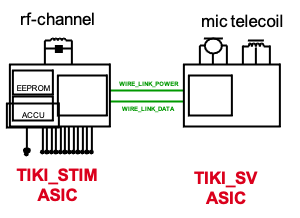
Subsequent development of this concept is aimed at an implant system that can be used for extended periods of time without an external component. For this purpose, the battery and microphone are implanted into the ear as well. To achieve viable function, it is necessary on one hand to make signal processing as energy efficient as possible, which was achieved by developing an application specific integrated circuit (ASIC). On the other hand, robust high frequency connections for transcutaneous transmission of data and energy have to be established to grant an efficient solution to recharge the implanted battery as well as to make it possible to use external microphones or similar devices.
Combined vestibulo-cochlear implants
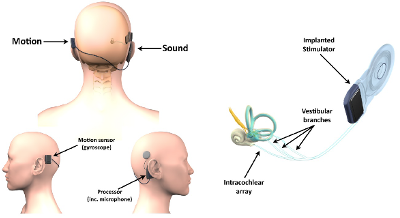
here are a number of ailments in the inner ear that do not only affect cochlear function, but also the vestibular organ. The close proximity of both organs suggests that for conditions that cannot be relieved without invasive surgery, a combined implant to stimulate both cochlea and vestibular organ could be utilized. These kinds of systems are not commercially available to date.
In this project, an audio-motion-processor (AMP) which can create a combined stimulation strategy for both cochlear and vestibular electrodes is developed. While audio information is recorded as usual via a microphone, the information about the motion is measured via a gyroscope sensor attached to the head. There are already prototypes for electrodes that branch off to the cochlea as well as to the vestibular organ. Some of these prototypes have already been implanted in patients.
The main task of the AMP is to facilitate the simultaneous usage of both organs and to reduce unwanted interactions by a suitable choice of the stimulation strategy, i.e., the exact order and length of stimulation pulses. Conceptionally, the AMP is a battery powered, lightweight wearable device to make testing with as much freedom of movement possible.
Simultaneous stimulation using Channel Interaction Compensation (CIC)
One of the most successful strategies for electric stimulation of the auditory nerve is the so-called “continuous interleaved sampling” (CIS) strategy, the standard strategy in many modern cochlear implants. A fundamental characteristic property of CIS is a strictly sequential excitation of individual electrodes in the cochlea without temporal overlap.
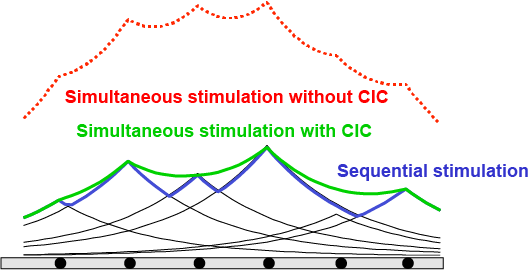
The individual electrodes are stimulated with a fixed pulse rate, meaning that CIS can only use amplitude information of the enveloping function at fixed times, but not the rapidly varying underlying component of the signal, the so-called fine structure.
While information conveyed through the envelope function is most important for speech recognition primarily in “western” languages, the temporal fine structure is significant for pitch perception and localization of audio sources. In tonal languages like mandarin Chinese, Cantonese or Vietnamese it can be advantageous to take into account both envelope and fine structure information. If this additional information contained in the fine structure should be passed to the auditory nerve, higher pulse rates are necessary. This can only be obtained by decreasing pulse lengths while at the same time increasing pulse amplitudes. However, there are limits to the maximum stimulation amplitude given by the supply voltage of the implant on one hand and by fundamental properties of the involved nerve fibers on the other hand.
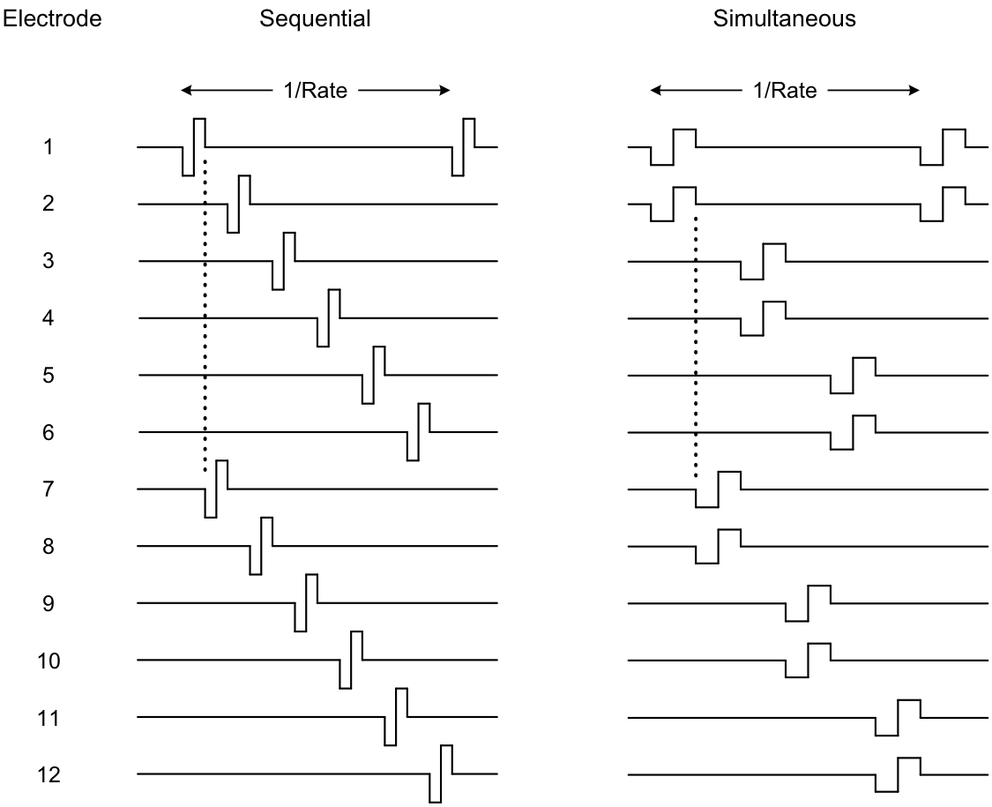
These shortcomings can possibly be remedied by a paradigm of simultaneous stimulation, contrary to the previously described non-overlapping CIS paradigm. The so-called channel interaction compensation (CIC) is a method to compensate the electric fields elicited by neighboring electrodes at the position of a specific electrode. The electric fields generated by individual electrodes are modeled by exponentially decaying fields and the amplitude reduction is calculated using the inverse interaction matrix.
There are two advantages of applying this paradigm: on one hand an increase in pulse rate can be reached by simultaneous stimulation, which is an advantage for the implementation of flexible fine structure strategies. On the other hand, even for sequential stimulation a reductio of pulse amplitudes can be reached, which offers both the opportunity to use longer pulse durations as well as a chance to reduce energy consumption at the same speech perception and hence may lead to longer battery life.
Reduction of eddy currents using ferrite sheets
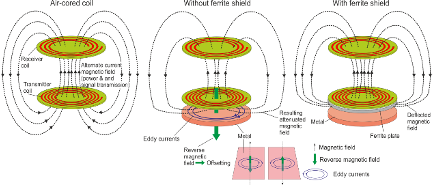
There is increasing demand for miniaturization in inductive transmission systems, which has the unwanted side effect of reducing the effective distance between transmission coils and other metallic components of these systems. This increases the probability to induce eddy currents in these metals, leading to losses in the system and in turn a deterioration of transmission efficiency in the inductive link.
The introduced losses can be reduced by magnetic shielding of the transmission system against metallic surfaces with the help of ferrite sheets. These ferrites are effectively magnetic mirrors due to the high magnetic permeability and significantly change the geometry of magnetic field lines, prohibiting penetration into the unwanted metal surfaces and thus also reducing eddy currents.
In particular for inductive transmission systems with dimensions similar as those used in cochlear implants, it can be shown that the transmission efficiency can be largely retained, when ferrite sheets with a comparable size to the coil cross section of the inductive link are used. Due to this, ferrite sheets present a viable solution for already existing systems. The change in magnetic field topology also leads to a changing inductivity of the system, and therefore also to possible changes in transmission parameters like the resonance frequency. If the inductivity needs to be retained in presence of a ferrite sheet, the number of coil windings has to be reduced in turn. Then all relevant transmission parameters can again be made consistent with the parameters of the original unshielded system.
Further topics:
- Stimulation strategies in apical regions of the cochlea
- Sigma-Delta sine generators with reduced noise
- Speech perception with fine structure stimulation
- Fast fundamental frequency detection with adaptive cross correlation
- Algorithms and prototypes to emulate nerve efferents of the medial olivocochlear complex (MOC) in binaural cochlear implant systems
